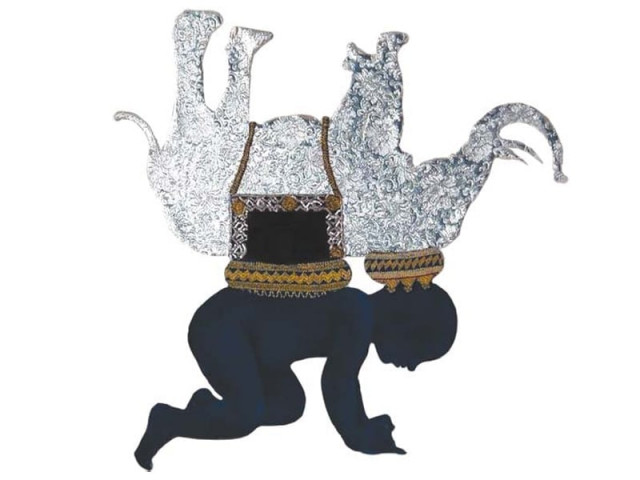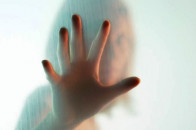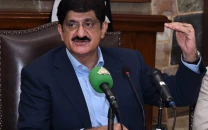Ambiguous journey: An artist and a sculptor compare the country’s ‘metal’
One believes that Pakistani passion can conquer all, the other compares us to sheep.

In sculptor Asad Hussain’s ‘Like don’t like’ piece fibre-glass and steel dogs are angled to like leaders with a looking glass behind them. Whether she likes it or not, the observer sees her reflection and finds herself in the piece, with the dogs, as a part of society. Hussain’s experiences have convinced him that men have reverted to animalistic behaviour. Artist Farooq Mustafa, on the other hand, has worked with journeys through time and space that have filled him with hope. Curator Munawar Ali Syed brought together their contrasting messages and choice of media together in a two-artist show at the Canvas Gallery last week.
Hussain fancies himself an anthropologist, investigating herd behavior by comparing sculptures of men with those of sheep. His pieces are politically charged with a cynical outlook on what he feels is a deterioration of the masses’ mental strength.
‘Survival’ is a foam scultpture of a sheep. “If you look at the way it is placed at the exhibition, the sheep is standing on its hindlegs, looking out hopefully. Just like us, as a country, we are all waiting for soemthing.”
In the end though, the men and the sheep are made out of the same fibre-glass, foam and leather. ‘Democracy’ shows that the only difference is that the man is wearing a Jinnah cap, putting him in power. His piece titled “Power Play” is about the new generation and foreign influences. It features a child on all fours with an elephant on his back. “Usually kids play with toys, but now the toys are playing with the child. The child is holding up a weight. Imported ideas and items are weighing him down. First man was on two feet, now we’ve been brought to our knees.”
Mustafa, on the other hand, spent the last 10 years in Tokyo. For him, memories of growing up in Hyderabad have morphed into surreal, dreamlike images.
This today helps fuel his art.
“Looking through myself I try to pick ingredients from my surroundings and construct my own version of reality, narrative, vibrant yet ambiguous,” he says.
Mixing markers with pencils and acrylics with oils, he tries to make his point with a “touch of romanticism”. The romanticism hooks up well with the shades of nostalgia he perhaps feels.
Despite his time in Japan, however, Mustafa has not tried to force their linear, unrealistic style into his work. Though inevitably, some of the use of the space characteristic of Japanese art does find its way into Mustafa’s paintings.
On the whole, his vibrantly colourful work is meant to be a message of potential and promise. He uses plenty of red in his work, and many of his landscape skies are crimson, a colour which, he claims represents hope. “We relate it to blood and negative thoughts, but I’ve used a shade that isn’t irksome. It’s a happy hopeful shade - if you stand before it, it doesn’t depress you.”
The optimist in Mustafa has not been quashed by his time abroad. He claims Japan, though fast-paced, is a lot more peaceful than cities here. “We have a lot more mental stress here.”
“But we still have hope,” he said, “despite all that we are going through I still feel there is a lot of ‘jazba’ and strength.” He uses wide blank spaces in some of his pieces, space that signifies the untapped potential in Pakistanis. “I think that we all feel like there is emptiness inside us, that we can do more.”
Published in The Express Tribune, April 20th, 2011.



















COMMENTS
Comments are moderated and generally will be posted if they are on-topic and not abusive.
For more information, please see our Comments FAQ